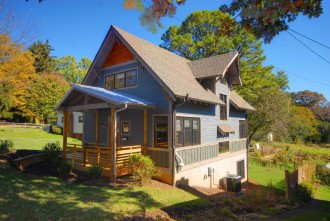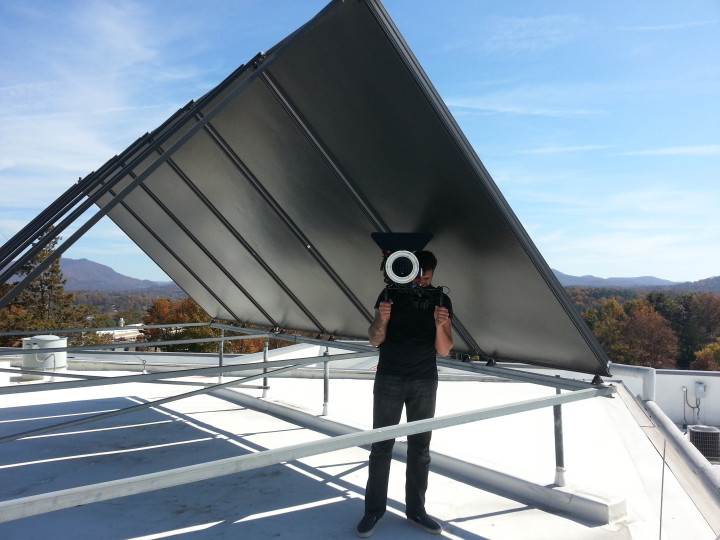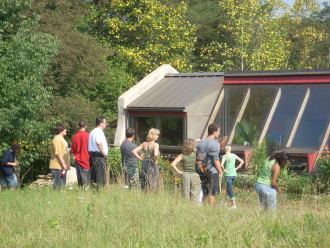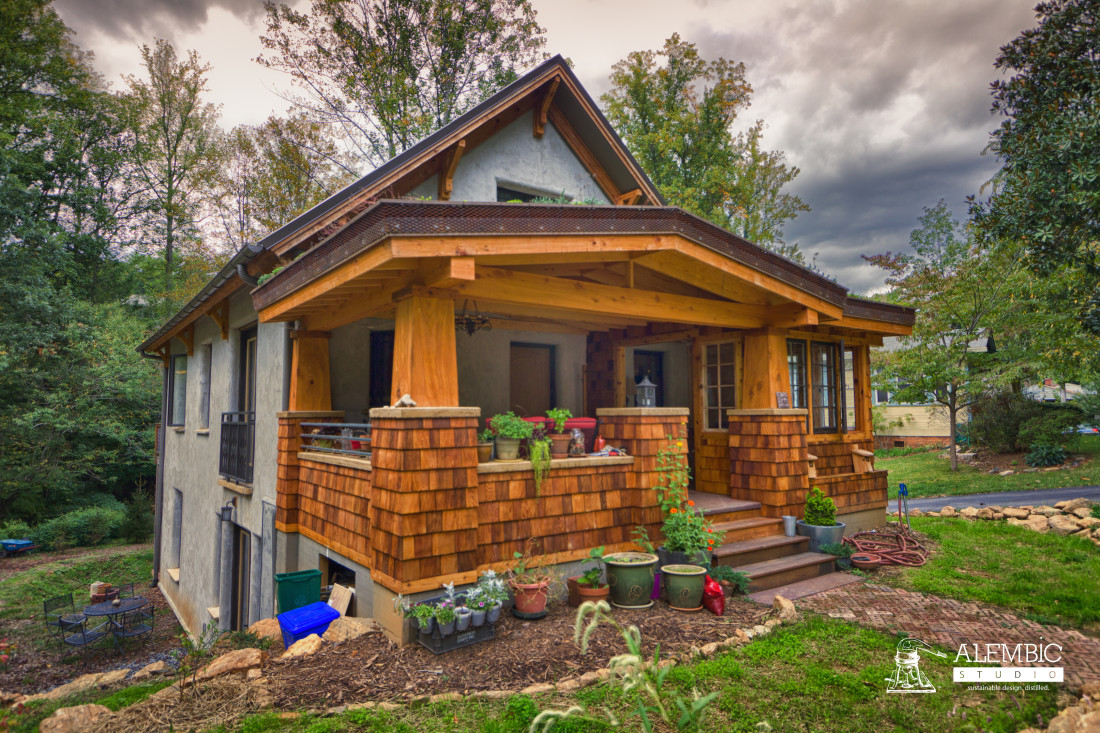Amid a hostile legislative climate in Raleigh, innovative, sustainable design and construction are flourishing in Western North Carolina. The WNC Green Building Council was founded in 2001. Since then — and despite an unstable housing market — local interest has grown steadily, says Maggie Leslie, who joined the organization in 2003 and is currently serving as interim executive director.
Even after the 2008 crash, she notes, “Many green builders — building in the right location and at the right price point — continued to be successful. Certified homes retained their value while other homes saw their value decline.” And as the regional housing market has recovered, says Leslie, green building has exploded. In March, the council celebrated the region’s 1,000th green-built-certified home, designed by local firm JAG Construction.
“The community is passionate about green-built homes because they’re better for the environment, health, the pocketbook and simply better built,” says Leslie. “Everyone wins: Homeowners enjoy a healthier environment, longer-lasting structures and increased savings on utilities; builders increase their profit margins and marketability; and there’s less long-term environmental impact.”
Sustainability is a key component of green building, and energy issues loom large in that equation. North Carolina is a leader in renewable energy, ranking first in the Southeast and fourth nationally in installed solar capacity, and second in the U.S. for implementation of large-scale renewable energy projects, according to a Pew Charitable Trusts report.
Proponents, though, say continued attempts by state lawmakers to curtail or eliminate the groundbreaking Renewable Energy and Energy Efficiency Portfolio Standard could have a devastating impact on North Carolina’s progress toward a more sustainable future. Passed in 2007, the law requires utilities to incorporate renewable energy sources into their overall production.
Several bills currently under consideration would reduce or eliminate tax credits and renewable energy mandates currently in place; a similar law was proposed in 2013.
“Powerful industries and special interests seek to maintain an unsustainable status quo,” says Heath Moody, a member of the WNC Green Building Council’s Board of Directors. Those same forces, he contends, are making “efforts to stop advances in energy-related building code upgrades.”
Laying the foundation
As far back as the early 1990s, efforts to publicize green building concepts and make energy-saving construction more affordable were on the rise. In 1993, Rick Fedrizzi, David Gottfried and Mike Italiano founded the U.S. Green Building Council to promote sustainability in the industry, working with businesses and nonprofits across the country to implement standards for green construction and accreditation.
Since that time, voluntary certification vehicles like the Green Building Council’s Leadership in Energy & Environmental Design and the Environmental Protection Agency’s Energy Star program have become powerful drivers of both residential and commercial construction, and the number of builders, organizations and contractors “going green” has increased dramatically.
There’s a reason for the focus on construction: Buildings account for 38 percent of all carbon dioxide emissions in the United States and 73 percent of the nation’s total energy consumption, the U.S. Green Building Council reports. In comparison, says Ali Peterson, communications specialist for the Washington, D.C.-based nonprofit, LEED Gold-certified buildings cut energy use by roughly 25 percent, water use by 11 percent, have 19 percent lower annual maintenance costs and 34 percent lower greenhouse gas emissions than conventional structures.

Meanwhile, many values espoused by the industry have shifted from the fringes to the mainstream. “Today,” says Peterson, the council’s constituency “includes builders and environmentalists, corporations and nonprofits, elected officials and concerned citizens, teachers and students.” In a 2014 Nielsen global survey, she notes, 55 percent of corporate respondents said they were willing to pay extra for products and services provided by companies committed to making a positive environmental impact, up from 50 percent in 2012 and 45 percent in 2011.
From concepts to code
A particular green building’s design is largely determined by the structure’s intended use and the client’s budget, says Leslie. “Green building begins with quality construction; then we begin incorporating more durable, longer-warranty materials. The bells and whistles come next, as options.
“Simple steps such as air-sealing, sealing HVAC systems and increasing insulation are cost-effective, deliver instant savings and make buildings more comfortable,” she continues. And by focusing on reducing energy usage at the individual consumer level, “renewable energy becomes more cost-effective” for others to implement into existing and new structures.
Thorough planning is needed before construction even starts, notes Moody. Advanced framing techniques that don’t entail additional costs, he says, “are starting to become more the industry standard.”
Recent advances in insulation materials and design, he explains, are also becoming more common within the industry. Adding a “thermal skin” of rigid insulation just beneath the exterior surface, for example, “helps block the thermal bridging of heat moving through the wall studs,” more effectively maintaining internal temperatures.
Building codes are starting to incorporate such techniques, notes Moody: “We’ll most likely see it become a requirement in new construction as we seek to reduce the massive amount of energy used by the construction industry.”
Meanwhile, WNC Green Building Council co-founder Duncan McPherson cites three main aspects to green technologies’ appeal: economics, health and comfort. Reduced costs as well as federal and state tax credits for homeowners who invest in renewable energy, he notes, have fueled solar power’s growing popularity over the last five years.
But green building “isn’t just solar panels and insulation,” says McPherson, a principal at Samsel Architects. It also involves “creating healthy environments in our homes, offices and schools. Air quality, daylight and even the chemical makeup of the products surrounding us in buildings have a tremendous impact on our health.” He adds that while “It’s easy for folks to just think about a green built house,” green building is making strides in commercial designs, factories and churches as well.
Comfort, he adds, is a significant benefit that’s often overlooked. “One of the tenets of green building is to create spaces that have consistent temperatures, ample fresh air and are free of mold.” Besides improving quality of life, these factors affect people’s ability to function. “Healthy, comfortable employees will do better work and make more money for a business,” says McPherson. “Healthy, comfortable students will be more focused and will learn more effectively.”
Money, politics and (solar) power
Not everyone shares these advocates’ enthusiasm, though, and the road to a green energy future still faces significant hurdles.
“Access to financing and proper valuation during appraisal,” says Leslie, “is probably the No. 1 obstacle” to the green building industry’s future growth. Innovative financing that lets property owners pay for improvements with the savings incurred over time, she notes, is available for many commercial buildings but less common with residential structures.

And meanwhile, several legislative efforts in Raleigh threaten to derail the progress being made in the green building and renewable energies industries, says Moody. “A seemingly harmless piece of legislation titled N.C. Energy Ratepayers Protection Act,” for example, would freeze the state’s renewable energy requirement at 6 percent and eliminate it altogether by 2018. In the meantime, companies would be allowed to satisfy half of it merely by increasing the efficiency of traditional resources.
The proposal, also known as H.B. 681, is supported by conservative groups such as the American Legislative Exchange Council, which claims “nearly one-quarter of the country’s state legislators” among its membership and is dedicated to “limited government, free markets and federalism,” according to its website.
Proponents say the bill would level the playing field for all energy suppliers and ultimately benefit consumers by driving down utility costs.
An April 15 article in the Carolina Journal quoted Rep. Chris Millis, who’s co-sponsoring H.B. 681, as saying, “This bill is focused solely on protecting the ratepayer.” If renewable energy is as affordable and accessible as industry members claim, argued Millis, it shouldn’t need subsidies.
Duke Energy spokesperson Randy Wheeless says the giant utility is remaining “neutral” on the bill, though he’s quick to add that the company is in compliance with the current standards and plans to meet the 2021 goals.
“This is not a bill that we asked for in any way, shape or form,” stresses Wheeless. “In fact, we feel very comfortable with where we are in our REPS compliance.” Duke, he continues, has benefited significantly from the renewable energy tax credits, but “we’ll be fine with whatever the General Assembly wants to do in that area.”
Meanwhile, another bill, H.B. 332, would also freeze the renewables requirement at 6 percent; the current law gradually increases it to 12.5 percent by 2021. Still other proposed legislation would eliminate tax credits for renewable resource projects. And though these proposals seem unlikely to gain approval in the current session, portions of them could be included in other bills.
Many in the green building industry strongly oppose such efforts. McPherson, for example, calls H.B. 681 “inaptly titled legislation that would hurt North Carolina’s green building and emerging clean energy economy.” If enacted, he maintains, the law could cost the state thousands of jobs and discourage investments in renewable energy.
Moody concurs, saying, “The meager incentives that renewable energy get are a drop in the bucket compared to the subsidies of fossil fuels & utilities.” According to the International Monetary Fund, energy companies around the world receive over five trillion dollars in subsidies, or roughly seven percent of the global GDP.
Moody likens the current incentives and subsidies for green building to the Roosevelt administration’s programs in the 1930s. FDR’s New Deal policies, he maintains, “created jobs by building the Blue Ridge Parkway and many other civic projects” that helped “lift us out of the Depression and rebuild a strong middle class,” enabling many Americans — including Moody’s own grandfather — to become “job creators.”
A promising future
Despite these challenges, many in the green building industry foresee a bright future. As the popularity of green design and renewable energy elements continues to grow among consumers and businesses, says McPherson, the focus will increasingly shift from new structures to retrofitting existing buildings.
These days, he notes, “Building owners are more knowledgeable about the benefits of green building, so the demand is there in the market.” The big question now is whether policymakers will continue to support the market with legislation that facilitates future expansion.

“The modern energy efficiency movement began with the energy crisis of the 1970s,” says McPherson. “Hopefully it won’t take another energy crisis for our leaders to realize that green building and clean energy are here to stay.”
In the meantime, the state’s current renewable energy policy is paying big dividends. Duke Energy, notes Wheeless, hopes to open four new solar facilities by the end of this year. The $500 million project will include some of the largest solar plants in North Carolina, capable of generating eight to 10 times as much power as those already operating in the state.
Improved building methods and reduced construction time for renewable energy facilities have made the move a logical one for the company, says Wheeless. “We’re excited about the four we’ve got under construction now, and hopefully we’ll have new ones to announce in the near future.”
Moody believes that supporting sustainable energy use and innovative green design concepts is a necessity if we wish to bequeath future generations a healthy environment. “There’s a mind shift that we all must accept: We’re on a pretty small planet that has 7.3 billion people.” And as developing countries across the globe increase their energy usage, he believes the time has come to “create an economy that values life, solution-oriented businesses and sustainable job growth.”
For her part, Leslie sees the current growth in the green building industry as a steppingstone toward broader sustainability goals.
Several of her organization’s current programs, she notes, point the way toward a sustainable energy future. Green Built NC, a statewide effort administered locally by the nonprofit, provides support for smaller-scale builders. And the Living Building Challenge, a collaborative effort with the International Living Future Institute, is a community-based project that aims to take green building to the next level: structures containing no toxic chemicals while achieving zero net energy usage and zero net water consumption (by collecting rainwater and treating it before and after use).
“We have the ability to build these homes,” she says, adding, “We just need the will.”



Great to see objective fact based reporting open with “Amid a hostile environment in Raleigh…”
I guess it was too much journalism to report that the the Boogey Man Bill (HB 681) hasn’t seen any action at all since April of this year, and that it hasn’t even made it out of, or possibly been heard, in a committee.
But as the MountainX reports – “IT COULD!!!”.
Maybe a better title for this baseless, scaremongering piece would be “They’re Coming For You!” or “They Are Trying to Crush Everything You Like and Hold Dear”.
Hi Henry,
Thanks for providing your opinion on this topic. You are correct that HB 681 has been bogged down in committee since the Spring. However, as you may know already, a bill is not considered officially “dead” until the Assembly breaks at the end of their session. So I would argue that HB 681 is still in play, though it may not seem to be going anywhere for the time being.
Also, portions of HB 681 have been replicated or have re-appeared in several other pieces of legislation which have gained more traction, such as HB 332, which I also mention. While HB 681 may be going nowhere, I think it’s safe to say that the measures proposed in HB 681 are still being debated actively in Raleigh.
I’m sorry that you did not enjoy the article. I guess we’ll have to agree to disagree on this one.
Max,
You have a thankless job, I’ll admit. My main beef with this is that you seemed to have had a foregone conclusion on this piece before you wrote it, which is “The GA is Coming For Your Renewable Standards”.
It’s unwarranted.
To get to this point, you misconstrue the legislative process which is misleading.
Using the standard of any bill is considered alive until the GA is gone is a wide, wide, scope. Just because some member introduces a bill about his or her pet peeve doesn’t mean the bill is going to get anywhere near passing. Under your standard though, any ill-advised bill is considered “alive” and could be passed, though in reality, that’s far from true.
You’re incorrect in that bills are alive until the end of the legislative session. Bills must meet the “Cross-Over” deadline, where it passes the House prior to some date in May, I believe. Maybe it’s June.
The bill you validly vilify the most, HB 681, never made it to the Senate before Crossover. That means it cannot be considered by the Senate in this legislative session. So it was dead a long time ago, but yet, here you have a whole article about how HB 681 could get the green building industry – even though that bill is dead by the rules of the General Assembly. While HB 332 has made the Senate from the house, it hasn’t seen any action in months. Hard to say that bills that haven’t seen action in months are still being “actively” debated.
Further, this isn’t the first time the NCGA has tried to shut down the renewable standard. Rep. Mike Hager was famously embarrassed last session trying to wipe out the renewable standard, and the NCGA, under Tillis, chose to keep it. Yet, that fact didn’t make the article at all. Here’s a report on the story: http://www.southernstudies.org/2013/05/nc-renewable-energy-law-survives-attack-from-the-r.html
Where I perceive your bias, I can’t help but think that facts like that one are excluded because either 1) you’re totally unaware, or 2) it’s a lot more fun to paint the NCGA as backward looking, anti-renewable energy cavemen than to recognize that it has already preserved the current law at least once.
It’s not that I disagree with you, it’s that your assessment of the status of the bills in the NCGA was incorrect and you chose to ignore recent history that doesn’t support the conclusion of your reporting.
Hi Henry,
I appreciate you continuing this dialogue, as I think it’s important to talk about this. I can say first off that I based my research into this topic on the responses and conversations I had with members of the industry around this area. Almost every person spoken with brought up this bill and similar measures as threats to the future growth of the industry.
I’m not sure where you’re getting this idea that I have it in for the GA. In fact, I specifically say in that section: “And though these proposals seem unlikely to gain approval in the current session, portions of them could be included in other bills.”
You are correct that a similar measure failed in the 2013 session. But I’d argue that that fact, coupled with the attempts during this current session to pass measures that would effect the REPS portfolio, means that there is still very much an active attempt to alter/reduce/freeze the mandates on renewable energy laid out by REPS. Just because something fails once, or even twice, does not mean that those opposed to REPS have given up. I think that the repeated attempts to introduce legislation like HB 681 supports that conclusion.
In fact, here’s an article from the VP of Outreach at the John Locke Foundation (who is in favor of HB 332), from Aug 20: http://www.fayobserver.com/opinion/local_columns/becki-gray-look-twice-at-energy-mandate/article_23d95292-ddb1-5b11-8546-546381078176.html
In regards to the status of HB 681: I spoke directly with an employee working in the General Assembly about the status of the bill, as I had similar concerns to the ones you’re raising. That individual told me that the bill cannot be considered “dead” or off the table until the end of the session. Just so you know I’m not “totally unaware” or ignoring facts to prove a point.
I appreciate the attention you have given this article, and am always looking for feedback on how to better do my job. Space and time allowing, a more in-depth look into the legislative process would have added to this article. I certainly will not claim to be the authority on our legislative process or green building. Hence why I consult those who work in those realms. But thank you for raising these points: I will take them into consideration for future articles, and hopefully they will help guide my future work.
Max,
You’ve educated me then. I thought the “cross-over” deadline was a firm dead line that prevented the bill from seeing any more life.
It was unfair of me to state that you have it out for the GA.
I suppose its my personal belief that the emphasis on this bill is overstated – though your story is informative. I just don’t see this bill coming to life so late in the day, especially as all of the focus is on the budget. But I suppose that’s where you’re there, is to pay attention to the possibilities.
Thank you for your reasoned responses and for bearing with me through the educational process. Keep writing.
Hey again Henry,
Thank you for speaking out about your feeling about this, and for participating in a reasoned and civil discussion. It means a lot and is very helpful to me when a reader voices his/her concerns about an article without going full internet-troll, as many commenters online are apt to do. I think you highlighted several key points in this article where I definitely could have been more clear and decisive in my wording, and I do sincerely appreciate that.
One thing I learned during my research for this article is that there is a fair amount of confusion on all sides about how the legislative process works, what the actual status of a bill is at any given time, and which bills relate to others. Part of that, in my opinion, comes down to a flaw in our national and state legislative processes. The multitude of similar bills at different stages of the process simultaneously in play is extremely hard to navigate for those who are involved in that process, let alone for you, me, or the average citizen.
Thanks for the kind words too! I expect and look forward to you and other readers keeping me in check and voicing concerns or critiques when they feel I’ve misstated something or haven’t done justice to the topic. That helps me to grow as a writer and journalist, and increases the community dialogue, which is our whole purpose here at Xpress.
Thanks again for reading and for engaging Henry. I hope you’ll continue to follow us and to contribute the news and events we cover. You’re just as valuable to what we do here as I am, and without concerned, engaged readers, there would be no point to any of this. Keep reading and commenting!